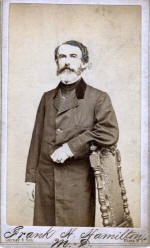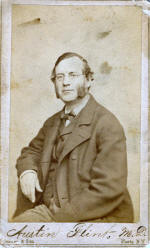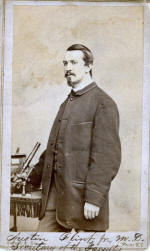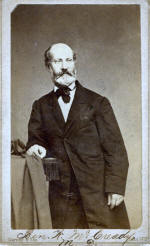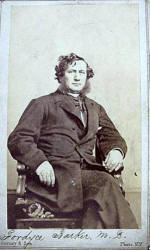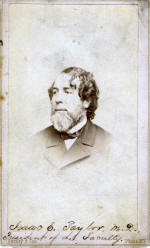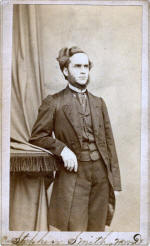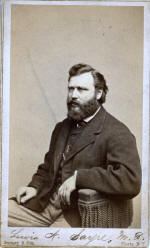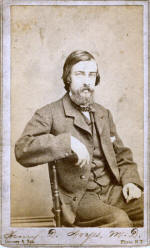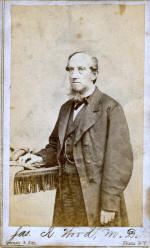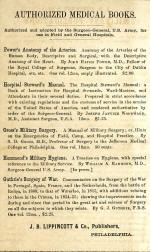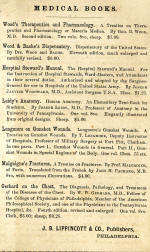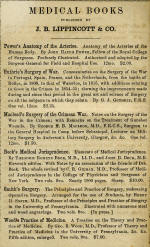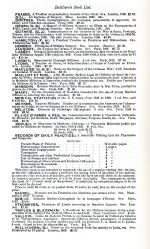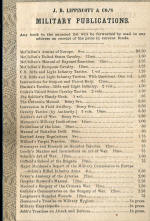During the period
just before the Civil War, a physician received minimal surgical training. Nearly all
the older doctors served as apprentices in lieu of formal education. Even
those who had attended one of the few medical schools were poorly trained.
The perception that 'doctors' or 'surgeons' knew how to do amputations or
any other kind of surgery is just wrong. Perhaps the practicing
surgeons in medical institutions were experienced at doing various
procedures, but the average student who had just graduated was severely
limited in surgical experience. As the Civil War started, there were
very few experienced surgeons to handle battlefield wounds. The Union
Army had to 'screen' the applicants who wanted to serve because so few were
qualified.
In Europe,
four-year medical schools were common, laboratory training was widespread, and
a greater understanding of disease and infection existed. Many U.S.
medical students attended medical school in Scotland, England, or Europe.
The average medical
student in the United States, on the other hand, trained for two years or
less, received practically no clinical experience, and was given virtually no
laboratory instruction. Harvard University, for instance, did not own a single
stethoscope or microscope until after the war.
Until tuition was instituted in 1871 at Harvard, salaries of Medical School
professors were raised through the sale of lecture tickets. See a list
of medical schools
in existence prior to and during the Civil War.
Another important point about medical
students in the 1800's is how few graduated verses how many attended in a
given year. Very few actually graduated. If you look at the
current year's registered students at
Albany
Medical College catalogue in a given year, and then look back at how
many actually graduated notice how few finished and actually
graduated. The large number of students on any given year could be
explained by both a high attrition rate, but also by students who wanted to
refresh their knowledge since lectures were sold on a ticket basis and
lecturers/doctors were paid by these ticket purchased for most of the
1800's.
University of New York, Medical Department, 1858, faculty, and graduate
list 1841 to 1858, surgeons who served in the War
Homeopathic and
Allopathic Physicians during the Civil War
Fraudulent
Medical Colleges in the 1800's
Civil War Surgery: The
truth about what surgeons did and did not do during the War
Medical student's
notebook from 1888, Univ. of New York, Medical College
Click on
any image to enlarge
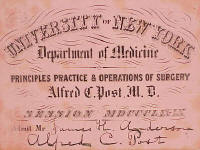
Lecture Ticket for Principles Practice & Operations of Surgery 1862 by
Alfred C. Post, M.D.
1861:Bellevue Hospital
Medical College opens at New York with New Jersey-born
physician Lewis Albert Sayre, 41, as the first U.S.
professor of orthopedic surgery.
Faculty of Bellevue Hospital 1864
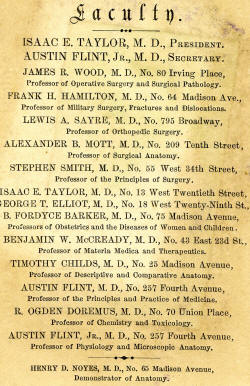
Below is a series of CDV's in this
collection of the Faculty
of Bellevue Hospital during the Civil War years
Faculty list for 1864-65
Bellevue Hospital (click to enlarge)
These doctors/faculty are some of the individuals who
published the texts used by the Union surgeons during the Civil War
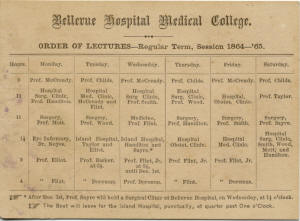
Lecture schedule for 1864-65
Bellevue Hospital (click to enlarge)
Typical Civil War medical topics:
Anatomy, Physiology, Materia Medica, Pharmacy, Therapeutics, Pathology,
Physic, Practice of Medicine, Surgery, Medical Jurisprudence, Medical
Police, Hygiene
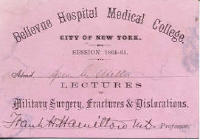
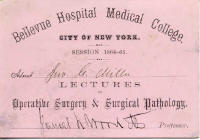
Lecture tickets for famous
Civil War surgeons: Dr.'s Hamilton and Wood
See
Surgical Manuals by the
most famous surgeons of the War
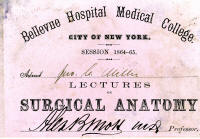
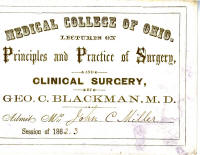
Civil War lecture tickets for Alexander Mott,
MD., George Blackman, MD
Extended list of
pre-1866 Medical College Lecture Tickets
Photographs of 1850's
surgeon/professors at Jefferson Medical College of Philadelphia
When the war began,
the Federal army had a total of about 98 medical officers, the Confederacy
just 24. By 1865, some 13,000 Union doctors had served in the field and in the
hospitals; in the Confederacy, about 4,000 medical officers and an unknown
number of volunteers treated war casualties. in both the North and South,
these men were assisted by thousands of women who donated their time and
energy to help the wounded.1
1. Source: The Civil War Society's "Encyclopedia of the Civil War"
Also see notes on the Army
Medical Dept. 1866 to extensive information about the
medical staff
in 1866.
The Civil War doctor, Surgeons as they
were called, ranged from the brave and brilliant to drunks and quacks. The
uneven quality was the result of political influence in the appointment of
some medical officers and wildly varying state-to-state standards in some
cases. One state required no medical degree from prospective surgeons on
grounds that "scholarship" was no "measure of practical ability", which may
explain the former barbers and similarly qualified men occasionally
commissioned as surgeons. The quacks deceived the public by their
irresponsibility. The qualified doctors deprived the public by their excessive
responsibility. They were so obsessed by quackery that they distrusted new
innovations, even when they were based on scientific theory.
Use of
chloroform and ether
during the Civil War on the battlefield.
In addition to the Army Surgeons, there
was the contract surgeon, who many times was not sufficiently trained to be
accepted by Army standards to be an officer. Contract Surgeons were paid
sometimes as low as $30.00 a month while an Army Surgeon might receive as high
as $100.00 to $130.00 a month depending on his rank and length of service.
During the War, 5,500 were engaged for periods of 3 to 6 months with only
about 1,500 serving at any one time. Many of the doctors still practiced
saddle bag medicine. The greatest share of the doctors at the beginning of the
war had never seen or treated a gunshot wound in their life.
Additional research
regarding American Civil War medical libraries
Confederate education during the Civil War at
Medical College of Virginia:
The medical school remained operational during the civil war, the only
southern medical school still in existence which graduated students
during the civil war. Just prior to the outbreak of the war, Hunter
Holmes McGuire led 300 fellow southern medical students from the
Jefferson Medical School in protest for the way they were treated, and
most (140) subsequently enrolled at the Medical College of Virginia.
During the Civil War McGuire also distinguished himself both as a
humanitarian and surgeon to Confederate General Thomas "Stonewall"
Jackson. At the wars end in 1865, he became the chairman of the
department of surgery.
The capital of the Confederacy had numerous and the largest hospitals in
the South. Among them was Winder Hospital with a capacity of 3000 beds,
and Chimborazo Hospital the largest with 8000 beds and most famous
hospital in the South. Opened in 1861, Chimborazo Hospital was led by
James McCaw, which at the time was the largest military hospital on the
continent. Some estimate that 75,000 patients were treated there during
the Civil War with an overall mortality of only 9%. Most of the records
relating to medical care in Richmond were burned in the great Richmond
fire just before its fall in April, 1865. Richmonders set the fires
themselves to prevent seizing of alcohol, tobacco, and other valuable
pillory. The Confederate States Medical and Surgical Journal includes
numerous accounts of head injuries treated at Chimborazo Hospital due to
shrapnel and bullet wounds.
Notes from: VCW University
A list of all the
medical schools in
existence during and before the Civil War. This would help determine
the education of a given surgeon and eliminate those schools not in
existence during the War.

